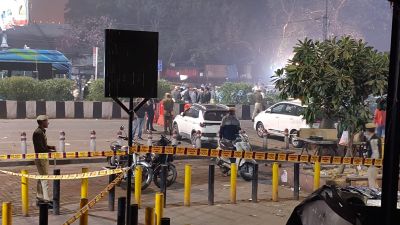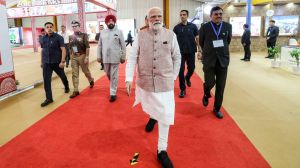News,uninterrupted
In the past year,when the economic downturn was at its worst,this was one business that showed no signs of slowing down,with 55 new news and current affairs channels getting permission to begin operations. Some 15 to 20 got on air. The Sunday Express tracks the boom....
Sitting in his office,in the presence of gun-toting security personnel,Matang Sinh rattles off the firsts that his broadcast business of six years is credited with. We are the first private satellite TV company to come up from the northeast. Our flagship news channel NE TV is the first in the world to broadcast news in 18 different languages, he says. We are the first ones in Asia to launch a bi-lingual news and current affairs channel (Focus TV) targeted at women.
The accomplishments notwithstanding,Sinhs claim to fame is not his success in the television news business,but his much longer and controversial political careerwhich explains the presence of security men in his officethat includes a stint as minister of state for parliamentary affairs in the late P.V. Narasimha Raos government.
Sinh,in fact,represents a larger trend of political parties,politicians or their kith and kin entering the news business,one of the fastest growing segments in television,not in terms of viewership or advertising revenue,but the number of new entrants. Besides politicians,the space has seen a hasty entry of some sundry small entrepreneurs from regional markets,with little background in broadcasting,in the past one-and-a-half years.
In fact,in the 15 months ended March 2009,around 55 new news and current affairs channels were given permission to begin operations in India and some 15 to 20 of these were launched during the period,which,incidentally,coincided with the time when the economic downturn was at its worst,and the media industry was struggling to make ends meet.
The boom
According to the 2008-09 annual report of the Information and Broadcasting (I&B) Ministry,211,or 54 per cent of the total number of 394 registered television channels in the country are news and current affairs channels. The report says while the number of all other channels put together has grown from zero in 2000 to 183 in 2009,the number of news and current affairs channels has grown from one to 211 in the same period.
It is bizarre. The total number of channels in countries such as the US may be a lot more,but the ratio of news channels to the total number of television channels is too high in India, says Timmy S. Kandhari,leader,media and entertainment practice of audit and management consultancy PricewaterhouseCoopers.
With a population of a little more than 800 million,spread across some 50 countries,and television connectivity of more than 80 per cent,the whole of Europe has around 162 news channels. According to data from the European Audiovisual Observatory,a public service body that gathers and circulates information on the audiovisual industry in Europe,TV viewers in European countries have an average of 21 national and international news channels to choose from.
According to industry estimates,India has a TV viewing population of around 600 million. While all registered news channels in India may not be operational,even with the current number of channels on air,the space is a bit too crowded,say media observers. Even in Asia,no other market has as many news channels as India, says Anjan Mitra,executive director,Cable and Satellite Broadcasters Association of Asia.
Interestingly,the I&B Ministry still has a large number of pending applications for new channels and there are many who feel Indian viewers are still left wanting for news. News is a grossly underserved genre. With the kind of population we have,we need more news channels in the country, says Vinod Mehta,managing director,Total TV,one of the recent entrants into the business. Sinh,who is all set to add a few more channels to his existing bouquet,agrees.
The surge in the number of news channels may make it seem that TV news draws in huge eyeballs and news channels are raking in top advertising dollars. The truth,however,is far from this. Viewership data from the Mumbai-based firm TAM Media Research reflects that news accounts for around 8 per cent of the total TV viewership. Within the genre,the viewership is divided like this: in the first six months of 2009,Hindi news accounted for 3.8 per cent of the total TV viewership,followed by regional news with a share of 3.4 per cent,English news with 0.44 per cent and business with a 0.4 per cent share.
In contrast,genres such as general entertainment and films draw in around 50 per cent and 17 per cent of the total TV viewership.
The share of news has definitely grown in the past four years,but that has largely been because of the expansion in the number of TV viewing households. Besides,the share of individual channels in the genre is extremely thin. The 23 per cent viewership that Hindi entertainment channels get is distributed among a handful of channels (around 11),whereas the 8 per cent of news viewership gets divided among a much larger number of channels, points out Kandhari.
The share of news channels in the TV advertising pie is even more dismal. According to estimates from the advertising industry,news channels accounted for only Rs 500 crore of the Rs 9,000-crore TV advertising pie in 2008. And around 90 per cent of this revenue goes to big players such as NDTV,Zee News,and TV Today,among others.
Most news channels that entered the business in the past three to four years are currently bleeding. Some of them,such as VoI,a Hindi news channel launched in 2008 by real estate company Triveni Infrastructure and Development Company,have had to halt operations because of financial constraints.
Our bread and butter,as of now,comes from bank loans, says Jyoti Narayan,managing director,P7,a 24X7 Hindi news channel launched with fanfare early this year. P7s promoter Pearl Group has varied business interests,including real estate.
The politics of news
Total TVs Mehta says there are three kinds of people entering the TV news business. One,politicians who want to use their channels to their benefit; two,businessmen wanting to enter politics or gain political influence; and three,entrepreneurs who want to be in the broadcast business,of which news is a crucial part, he says.
Mehta himself was media adviser to former chief minister of Haryana,Om Prakash Chautala,before he entered the news business. He is supported in his current venture by his partner,Anil Gaba,an exporter from Panipat.
At present,there are more than a dozen prominent news channels across the country,which are,directly or indirectly,controlled by politicians or their close relatives. Some political parties,including the ruling Congress,run television channels of their own.
Most of these channels were put to good use during the elections. Everybody promoted their own candidates and agenda. Maligning opponents is commonplace on such channels, says a senior editor of a leading news channel based in Chennai.
Some players are quite forthcoming about their agenda. Vasanthakumar,a sitting Congress MLA from Tamil Nadu,for instance,has no qualms admitting that he launched his channel,Vasanth TV,in May 2009,to support the Congress and Soniaji and Rahulji. We are a Congress channel with a national mindset. We give more importance to what the party does and to our leaders such as Soniaji and Rahulji, he says.
Tamil Nadu has the maximum number of channels owned by various political parties or their close aides (see chart).
Most developed broadcast markets do not allow political parties or politicians to run news channels of their own. The Telecom Regulatory Authority of India (TRAI),which partially regulates the broadcast industry,had recommended that news channels with any kind of political linkages should not be allowed to function,but the government recently set aside this recommendation.
Besides politicians,small entrepreneurs from regional markets also form a big chunk of the new entrants. The fact that the national advertising piethe main source of sustenance for news channels because most of them are free-to-air and hence,get no subscription revenuesis already squeezed,is not a deterrent for them. They also dont see their own lack of experience in running a broadcast business as a challenge.
We are not here to make money We launched the channel for the welfare of the society, says S.K. Gupta,managing director,SKG Group that launched TV100,a Hindi news channel,four years ago. SKG Group runs a hardware manufacturing and export business.
His sentiment is echoed by H.S. Sran,the promoter of national Hindi news channel CNEB,who says,It is for the good of the society (that we launched the channel). Srans family runs an extensive dairy,real estate and housing and consumer loans business.
Running the business
Being the media platform with the most penetration,television is a potent tool to reach the masses. Those in the business say launching and running a news channel is also a much cheaper and simpler business proposition when compared to launching a newspaper or even a general entertainment,sports or film channel. You need at least Rs 100-150 crore to launch a national non-news channel,whereas a news channel would cost anywhere between Rs 10-50 crore, says a broadcaster,not wanting to be named.
For other genres,the cost of content acquisition or production runs into several crores of rupees whereas for most news channels,content is almost free,thanks to the buzzing political,economic,and social scene in the country, says Ajay Upadhyay,director,Mediaguru,a company that provides turn-key broadcast business services.
A visible fallout of the crowding in of the space has been the mad chase of issues and elements that draw in eyeballs. There have also been complaints of some news channels using their platform to get even with people or derive undue favours. I&B Minister Ambika Soni has admitted to receiving such complaints.
Content on news channels has,in fact,been one of the most controversial issues in recent times and Soni has cited content regulation,though without direct government intervention,as one of the foremost priorities of the ministry. In the meantime,the ministry has sought TRAIs recommendations on whether a cap should be imposed on the number of TV channels in the country and also on the eligibility of those wanting to enter the broadcast business.
The eventuality of TRAI recommending a cap or advocating strict norms for new entrants will,however,have no bearing on the current players. For,they are inside the ring and the game has already begun.



- 0112 hours ago
- 022 hours ago
- 0312 hours ago
- 0412 hours ago
- 052 hours ago




























